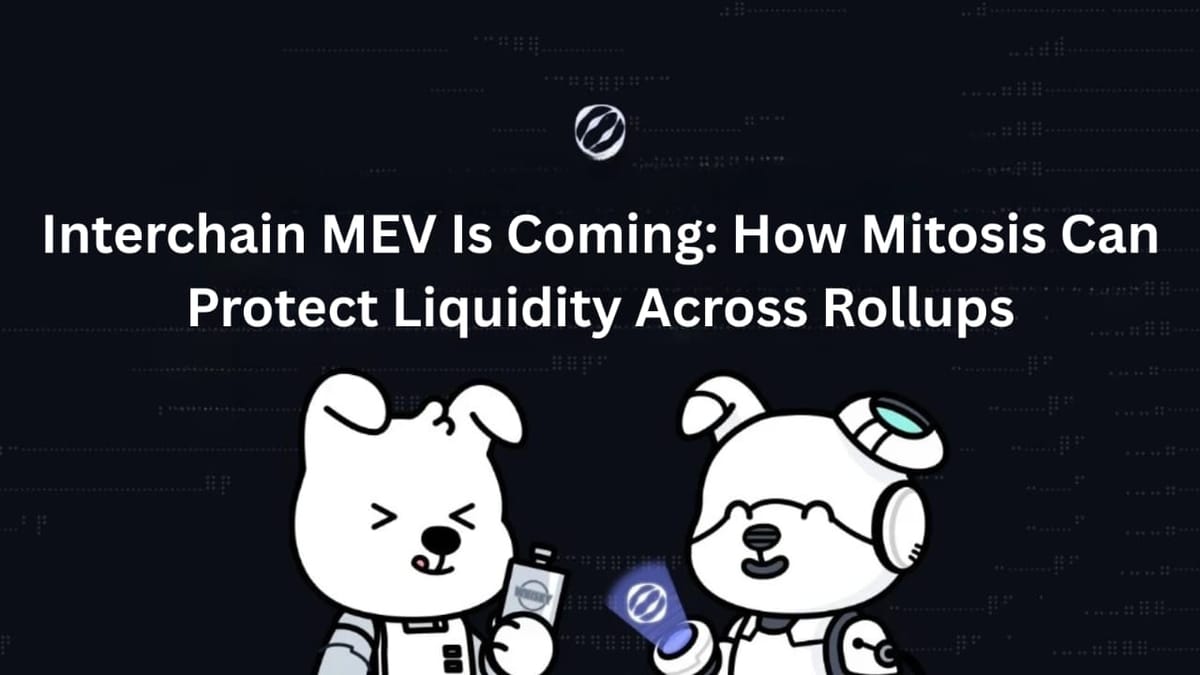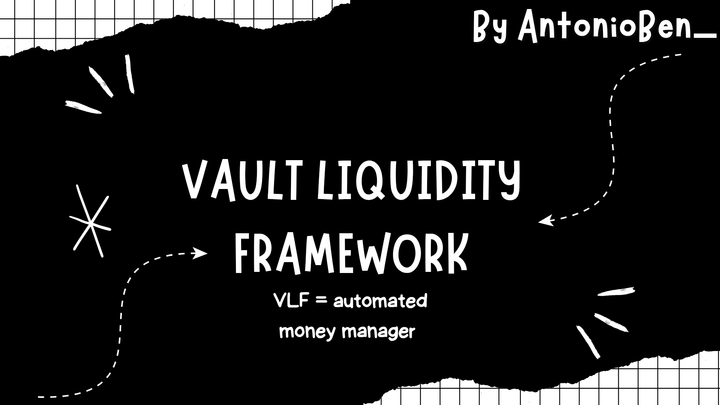Interchain MEV Is Coming: How Mitosis Can Protect Liquidity Across Rollups

Introduction
The blockchain ecosystem is undergoing a significant transformation with the rise of modular architectures, particularly in the context of Ethereum Layer 2 (L2) solutions and the Cosmos ecosystem. As these technologies evolve, they introduce new complexities, particularly concerning Miner Extractable Value (MEV). Interchain MEV presents unique challenges, especially in terms of liquidity fragmentation and market efficiency across various rollups and chains. This article delves into the intricacies of interchain MEV, the role of shared liquidity pools in mitigating harmful arbitrage, and how Mitosis stands out against traditional bridges in handling MEV scenarios
1. What Interchain MEV Looks Like
1.1. Definition of Interchain MEV
Interchain MEV refers to the potential profits that can be extracted from transactions that span multiple blockchains. In a modular world, where various rollups and chains operate independently, the opportunities for MEV become fragmented. This fragmentation can lead to inefficiencies, as traders and bots race to capture value from price discrepancies across different platforms.
1.2. Fragmentation of Arbitrage
In a decentralized finance (DeFi) landscape characterized by multiple rollups, liquidity is often dispersed. This fragmentation creates arbitrage opportunities when price discrepancies exist between chains. For example, if an asset is priced lower on one rollup than another, traders can buy low on one chain and sell high on another, pocketing the difference. However, as more participants enter the market, the competition intensifies, leading to a race to capture these fleeting opportunities.
1.3. Impact on Users
The presence of interchain MEV can negatively affect users in several ways:
- Increased Transaction Costs: As bots and traders compete for the same arbitrage opportunities, transaction fees can rise, making it less profitable for regular users to engage in trading activities.
- Slippage: The competition for MEV can lead to higher slippage, where the price at which a trade is executed differs from the expected price, further eroding user profits.
- Market Manipulation: Malicious actors may exploit interchain MEV by manipulating transactions to their advantage, undermining trust in the ecosystem and deterring users from participating in DeFi applications.
1.4. Security Concerns
The exploitation of interchain MEV can lead to security vulnerabilities. For instance, if a malicious actor can predict the order of transactions across chains, they may front-run trades or engage in other manipulative practices. This not only harms individual users but can also undermine the integrity of the entire ecosystem.
2. How Shared Liquidity Pools Reduce Harmful Arbitrage
2.1. Concept of Shared Liquidity
Shared liquidity pools allow multiple rollups and chains to access a common pool of liquidity, reducing the fragmentation that typically leads to harmful arbitrage. By pooling resources, these systems can create a more efficient market environment.
2.2. Benefits of Shared Liquidity
- Increased Capital Efficiency: By allowing liquidity to be utilized across different chains, shared liquidity pools enhance capital efficiency. Users can access better prices and lower transaction costs, as liquidity is no longer confined to a single chain.
- Reduced Price Discrepancies: With a larger pool of liquidity, the chances of significant price discrepancies between chains diminish. This makes it harder for arbitrageurs to exploit these differences, leading to a more stable market.
- Enhanced User Experience: Users benefit from lower slippage and better execution prices, as the shared liquidity helps stabilize prices across different platforms. This creates a more favorable trading environment for all participants.
2.3. Mitosis' Role
Mitosis aims to facilitate shared liquidity by creating a modular liquidity protocol that connects various rollups and chains. This approach not only enhances liquidity but also mitigates the risks associated with interchain MEV. By enabling seamless access to liquidity across different platforms, Mitosis can help create a more resilient and efficient DeFi ecosystem.
3. Mitosis vs. Bridges in Handling MEV Scenarios
3.1. Traditional Bridges
Bridges typically serve as connectors between different blockchains, allowing for asset transfers. However, they often operate on a permissioned basis, which can limit their effectiveness in a rapidly evolving multi-chain environment.
3.2. Limitations of Bridges
- Siloed Liquidity: Bridges often create siloed liquidity, where assets are locked in one chain and cannot be easily utilized elsewhere. This leads to inefficiencies and missed opportunities for users.
- Security Risks: Many bridges rely on centralized operators or validators, which can introduce vulnerabilities and points of failure. If a bridge is compromised, users may lose access to their assets or suffer financial losses.
- Limited Functionality: Traditional bridges may not support complex DeFi interactions, limiting their utility for users.
3.3. Advantages of Mitosis
- Permissionless Integration: Unlike traditional bridges that may require approval or rely on a trusted party, Mitosis enables permissionless connection between rollups and chains. This reduces central points of failure and democratizes access to liquidity pools.
- Dynamic Liquidity Management: Mitosis operates with shared liquidity pools accessible seamlessly across multiple chains. This dynamic approach to liquidity management enables capital to flow more efficiently, reducing fragmentation and combating the race conditions and front-running associated with MEV.
- Improved Capital Efficiency through Derivative Tokens: Liquidity providers (LPs) in Mitosis receive derivative tokens representing their stake, which can be used within the broader DeFi ecosystem for additional yield opportunities. This composability maximizes LP capital efficiency beyond simple asset locking.
- Security and Decentralization: Mitosis leverages decentralized protocols to safeguard against manipulation and exploits. The protocol carefully designs mechanisms to mitigate MEV extraction risks that typically plague bridges relying on centralized operators.
- Optimized for Modular and Layer-2 Solutions: Mitosis is built from the ground up for the increasingly modular blockchain ecosystem. It naturally integrates with rollups on Ethereum and the Cosmos ecosystem, supporting heterogeneous chains and accommodating interoperability standards like Inter Blockchain Communication (IBC).
4. Deep Dive: How Interchain MEV Manifests in Modular Ecosystems
Understanding interchain MEV requires grasping how modular chains and rollups operate. In the modular paradigm, blockchains specialize in separate tasks execution, consensus, data availability and rollups inherit execution while depending on base layers or central hubs for data consensus.
This leads to environments where arbitrageurs and bots monitor multiple chain feeds and transaction pools to extract value by submitting transactions that profit from price differences across rollups or across markets on different chains.
4.1. Examples of Interchain MEV Techniques
- Cross-Rollup Arbitrage: Rapidly buying an underpriced asset on one L2 rollup and selling it at a higher price on another before price realignment.
- Sandwich Attacks Across Chains: Coordinated front-run and back-run transactions surrounding user trades that span chains, exploiting latency and order sequencing differences.
- Liquidity Extraction via Cross-Chain Bridges: Using bridge transfers as signals or triggers to exploit price movements or liquidity imbalances, sometimes aggravating slippage for regular traders.
These activities increase costs for users due to gas wars and higher slippage, undermine DeFi fairness, and stress rollups with amplified transaction volumes.
5. Shared Liquidity Pools as the Antidote
By pooling liquidity shared across rollups and chains, systems like Mitosis diminish incentives for fragmented arbitrage:
- Reduced Price Disparities: Larger, aggregated liquidity naturally narrows price gaps, compressing MEV margins.
- Unified Execution Environment: Shared liquidity means arbitrageurs can't easily capitalize on temporary inefficiencies isolated to smaller pools.
- Lower Gas Consumption and Faster Settlements: By providing more liquid options on each chain, users can avoid cross-chain transactions that are typically slower and costlier, lessening exploitable delay windows.
6. The Technical Backbone of Mitosis
Mitosis employs several layered approaches:
- Modular Liquidity Protocol: Establishing common pools accessible across rollups, reducing liquidity fragmentation.
- Derivative Tokens for LPs: These tokens represent a stake in the shared pool and can be used across DeFi, enabling cross-chain composability and amplified capital usage.
- Permissionless Chain Onboarding: Any compatible rollup or chain can integrate with Mitosis without custodial constraints, promoting broad ecosystem growth.
- Cross-Chain Security: Mitosis draws from cryptographic guarantees and decentralized governance to preserve pool integrity against MEV extraction and malicious front-running across environments.
7. Why Bridges Can Fall Short
Bridges generally transfer assets but are not liquidity protocols. Traditional bridges:
- Lock funds on one chain and mint wrapped tokens on another, creating isolated pockets of liquidity prone to fragmentation.
- Often rely on centralized or federated validators, creating trust assumptions and attack surfaces.
- Lack the dynamic liquidity provisioning and composability needed for modern multi-chain DeFi interactions.
These limitations expose users to risks: slow cross-chain transfers, higher fees, and greater vulnerability to MEV attacks prompted by price lag or transfer delays.
8. Mitosis and the Future of DeFi Liquidity
In a modular, multi-chain world, the absence of unified and dynamic liquidity is a critical bottleneck. Mitosis provides a protocol-native, permissionless solution that protects liquidity, minimizes harmful interchain MEV, and empowers users and developers to build sophisticated DeFi apps with confidence.
8.1. Summary of Benefits
Conclusion
Interchain MEV introduces a new frontier of challenges in our multi-chain, modular blockchain future. Fragmented arbitrage opportunities can drain liquidity, hike transaction costs, and degrade user trust across rollups and chains. Mitosis emerges as a compelling solution by providing a modular, permissionless liquidity protocol built to unify liquidity pools and dynamically manage assets across diverse environments. Its approach counters the pitfalls of traditional bridges and aligns with the needs of the evolving ecosystem.
For DeFi users, developers, and ecosystem builders, embracing shared liquidity models like Mitosis will be critical to sustaining efficient, secure, and fair markets as Ethereum Layer 2 scaling and Cosmos interoperability accelerate.
Resources and Further Reading
- Introducing Mitosis: The Modular Liquidity Protocol (Medium)
https://medium.com/mitosisorg/introducing-mitosis-the-modular-liquidity-protocol-bfa421273b80 - Scaling Cross-Chain Liquidity via Restaked ETH (Medium)
https://medium.com/mitosisorg/scaling-cross-chain-liquidity-via-restaked-eth-13f5dfbf6ed9 - IBC Eureka: How Cosmos' New Standard Solves Cross-Chain MEV
https://university.mitosis.org/ibc-eureka-how-cosmos-new-standard-solves-cross-chain-mev/ - Mitosis & the Future of Cross-Chain Liquidity: How Collaboration is Shaping DeFi 2.0
https://university.mitosis.org/mitosis-the-future-of-cross-chain-liquidity-how-collaboration-is-shaping-defi-2-0/ - DeFi MEV Explained (Flashbots)
https://docs.flashbots.net/flashbots-auction/mev-101 - The Modular Blockchain Paradigm and Its MEV Implications (Ethereum Foundation)
https://blog.ethereum.org/2023/07/07/modular-blockchains-explained



Comments ()